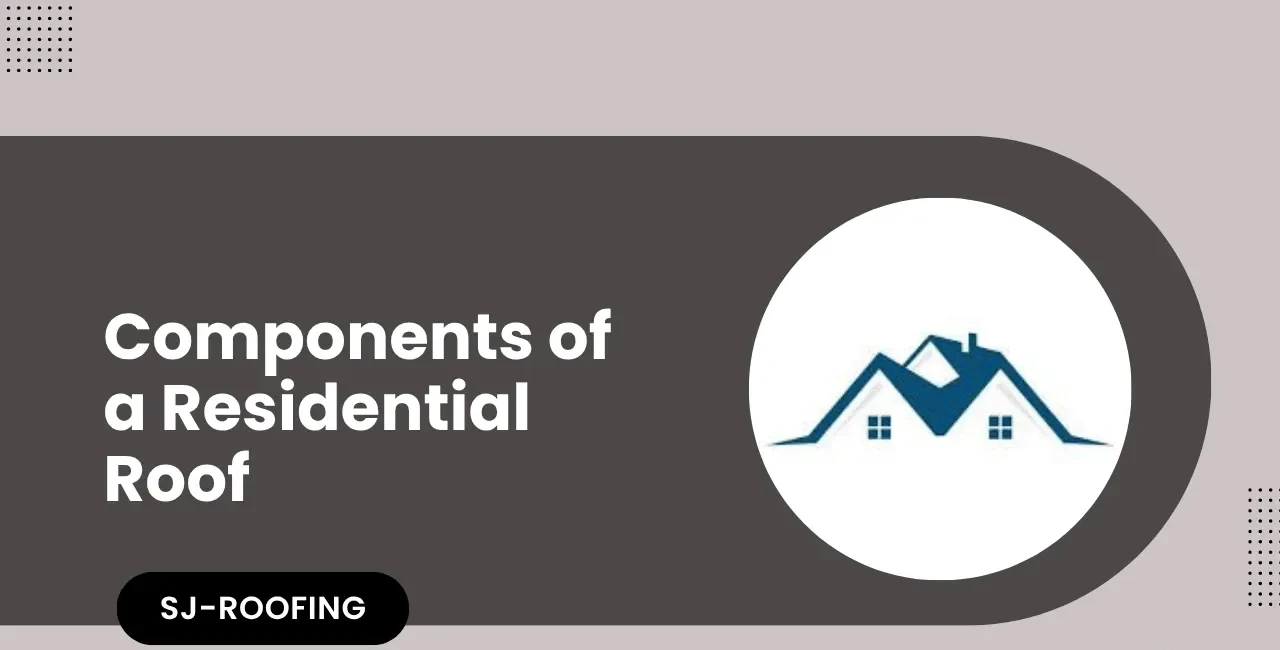1. Roof Covering
Okay, the roof covering is the outermost layer of the residential roof. It is the material you see from the outside and serves as the first line of defense against harsh weather—like rain, snow, wind, and direct sunlight, etc. This layer is critical because it prevents water leaks and other damages
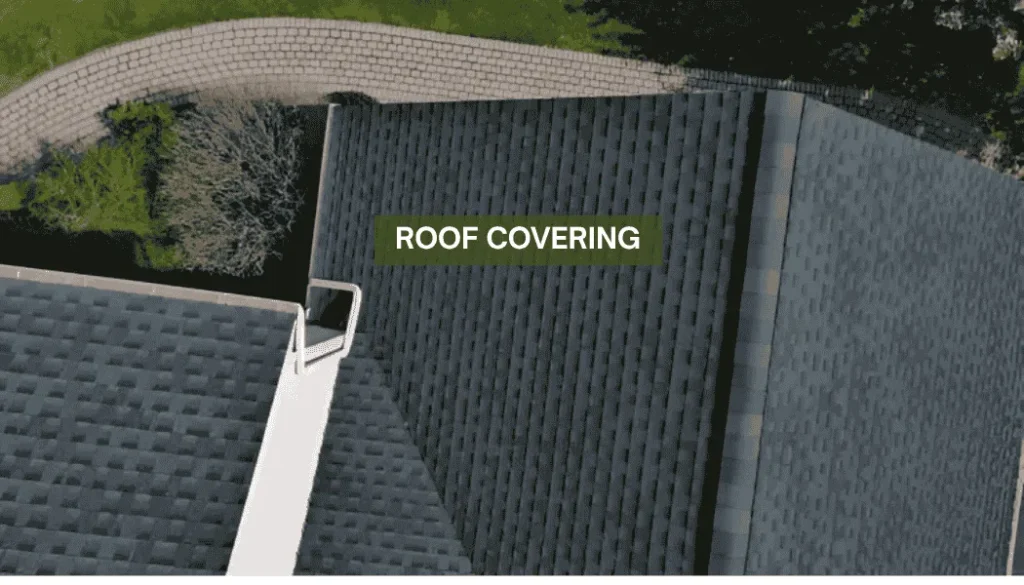
There are several types of roof coverings, including:
- Asphalt shingles (most common in many homes due to affordability and ease of installation)
- Clay or concrete tiles (popular in warmer climates for their durability and appearance)
- Metal panels (strong and long-lasting, often used in modern or rural-style homes)
- Slate tiles (a premium option known for its natural look and longevity)
Among these, asphalt shingles are the most widely and commonly used in residential buildings only, okay? They are cheap and come in a variety of styles, colors, and designs. They are also easy to replace and repair. The choice of roof covering depends on factors like climate, budget, style, and design.
But no matter the material, the roof covering plays a vital role in keeping your home safe and dry.
2. Roof Deck (Sheathing)
The roof deck, also known as sheathing, is the flat, basic layer that sits directly on top of the roof frame. It is usually made of plywood, interior board, or OSB (Oriented Strand Board). These are long-lasting and durable materials.
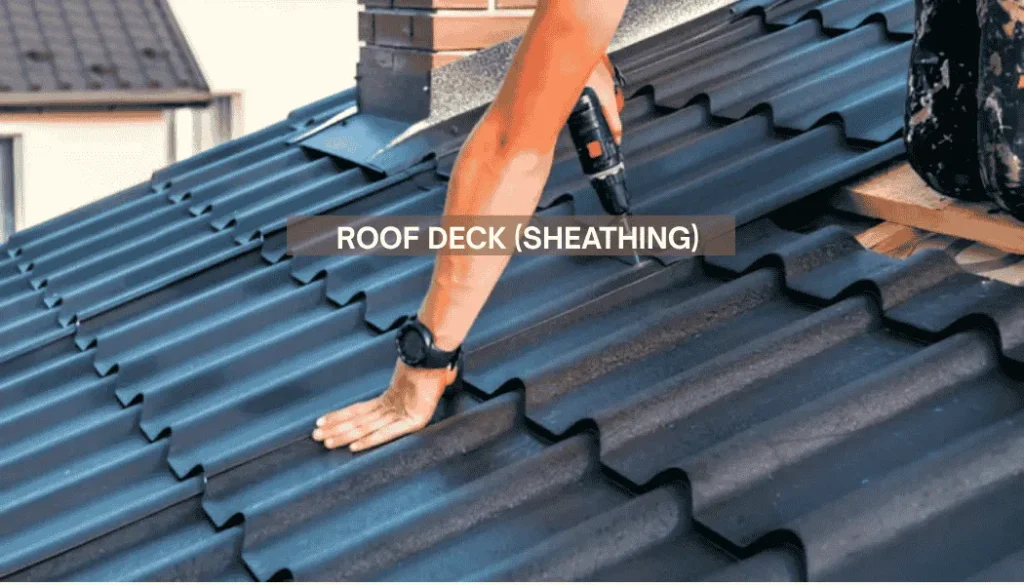
The main job of the roof deck is to support the roof, okay? It holds the shingles or tiles and provides a solid and strong surface for other roofing layers. It also connects all parts of the roof and helps it stay stable and strong, especially during heavy rain, snow, or stormy weather, you know?
If the roof deck is weak or damaged, the entire installation can be ruined. That’s why it is very important to keep it in good condition, especially during roof repairs or replacements. A strong roof deck is the foundation for a long-lasting and durable roof.
3. Roof Frame (Trusses or Rafters)
The roof frame is like the skeleton or inner structure of the roof. It gives the roof its shape, holds all the roofing layers, and supports the entire structure. It also connects with the roof covering, deck, and sometimes even includes the gutter and drainage system in some cases.
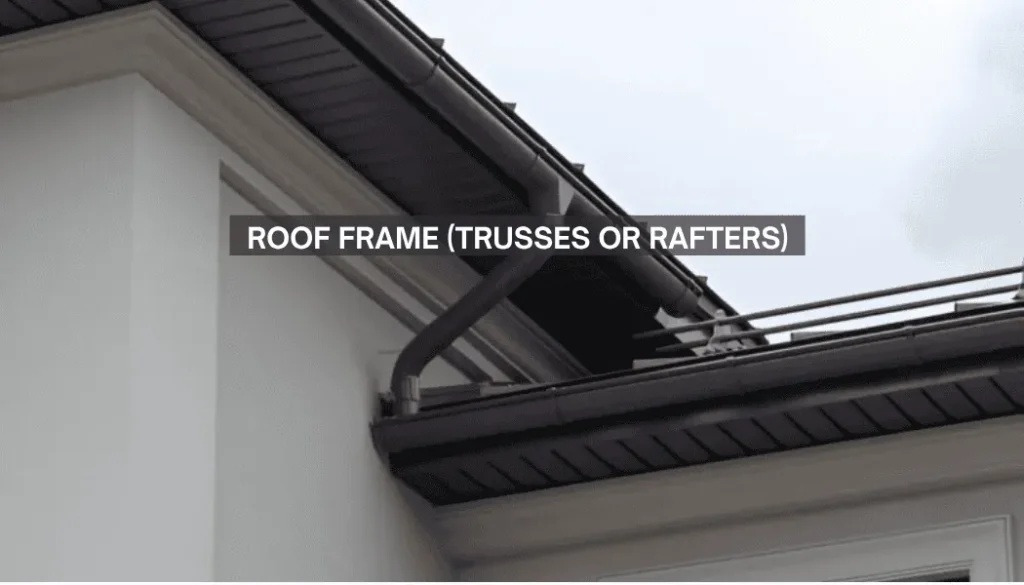
The roof frame is most commonly made of wood, but sometimes metal is used too.
There are two main types of roof frames:
- Trusses – Pre-built, triangular structures that are factory-made and quickly installed.
- Rafters – Traditional wooden beams cut and built on-site, often used in custom or older homes.
Both trusses and rafters are designed to spread the weight evenly across the walls of the house, making sure the roof stays firm and balanced. Without a strong roof frame, the roof could sag or even collapse under pressure.
In short, the roof frame is the backbone of the whole roofing system.
4. Underlayment
The underlayment is like a hidden and underneath component of the roof, you could say — but it is a very important layer in a residential roof. It is installed directly on top of the roof deck, under the shingles or tiles.
This layer is usually made of felt paper or synthetic waterproof sheets because they are strong and durable. Its main job is to provide extra protection against water leaks, especially during heavy rain.
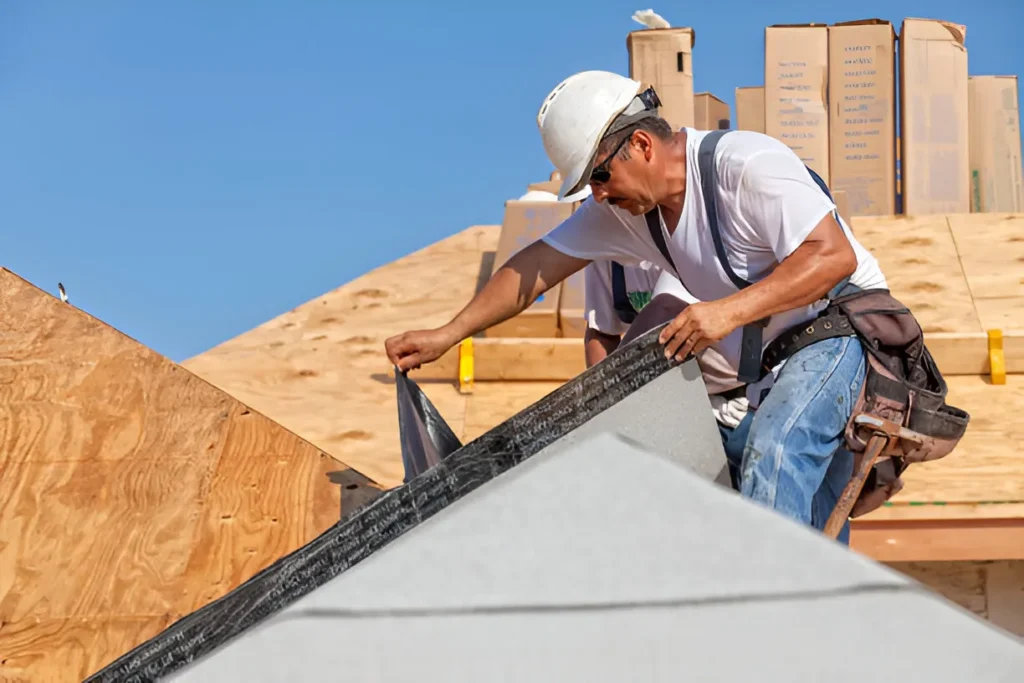
If the outer roof covering gets damaged or water slips through during extreme conditions like heavy rain or snowfall, the underlayment acts as a barrier — you know, a second layer of defense — to stop water from reaching the wooden deck.
There are two main types of underlayment:
- Asphalt-saturated felt (also called tar paper)
- Synthetic underlayment (stronger and more water-resistant than felt)
Even though you don’t see it, the underlayment plays a big role in keeping your home dry and protected from moisture, mold, and long-term water damage.
5. Ventilation System
A proper ventilation system is a very important part of a good residential roof. It includes things like ridge vents, soffit vents, and gable vents, and they all work together to maintain proper airflow.
The main purpose of ventilation is to control temperature and moisture. In warm or humid conditions, moist air can get trapped in the roof, which may lead to mold growth, damage, or even rotting.
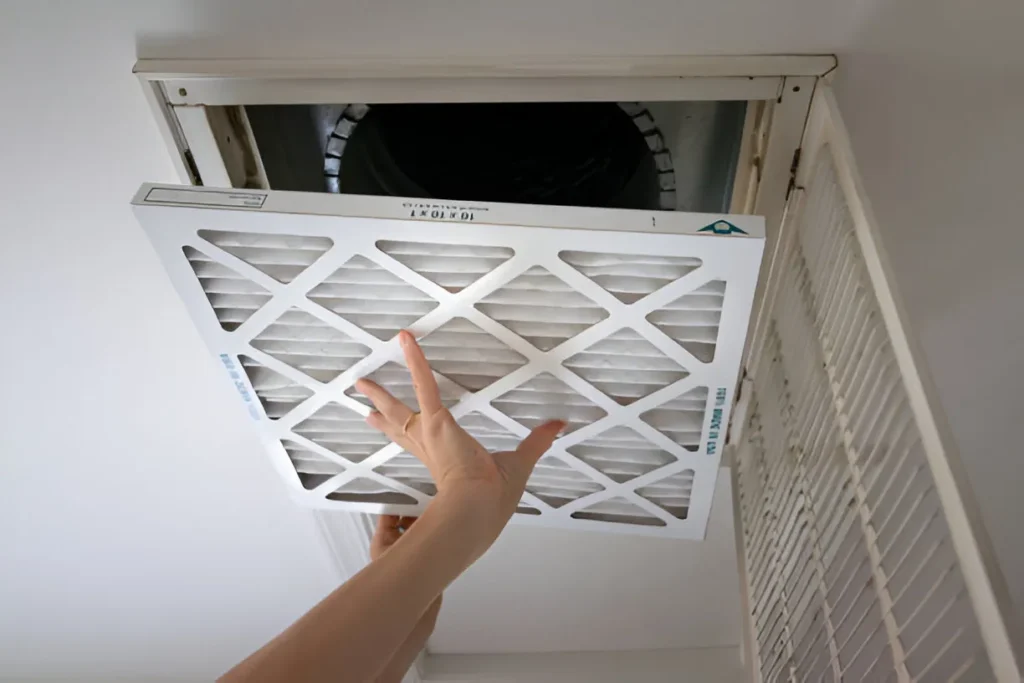
In cold areas, ice dams can form — these can cause serious roof damage and lead to water leaks and other problems.
Here’s how the system works:
- Soffit vents pull in cool, fresh air from under the roof’s edge.
- Ridge vents let hot, moist air escape from the top of the roof.
- Gable vents provide extra airflow from the sides of the attic.
With good ventilation, your roof lasts longer, your home stays cooler in summer, and moisture problems are kept under control. It’s a small part of the roof, but it makes a big difference!
6. Flashing
Flashing is also one of the most important parts of a residential roof. It is made of thin metal strips or metal sheets, usually aluminum or galvanized steel.
Flashing is installed in areas of the roof where leaks are most likely to happen. These are the weak points of the roof — you could say — where different parts meet or where something is attached to the surface of the roof, like chimneys, vents, or skylights.
Flashing is placed around:
- Chimneys
- Roof valleys (where two roof slopes meet)
- Skylights
- Roof edges and joints
The job of flashing is to redirect water away from these areas and safely off the roof. Without flashing, water can easily seep into small gaps and cause leaks, wood rot, or mold growth.
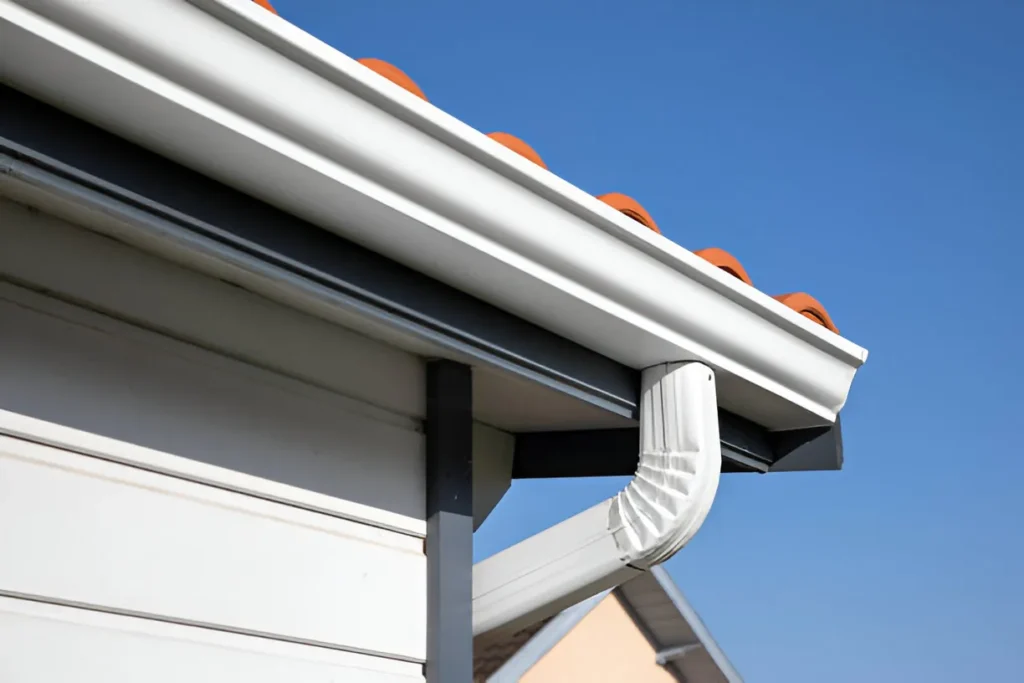
Even though it’s not very visible, flashing is one of the most important parts of a roof when it comes to water protection. A properly installed flashing system can save homeowners from costly water damage repairs.
7. Gutters and Downspouts
Gutters and downspouts are also a very important part of any roofing system. They work together to move rainwater away from the roof.
When it rains, water runs off the roof into the gutters, which are the open, narrow channels that run along the edges of the roof. From there, the water flows downward through the vertical pipes, called downspouts, which are attached to the side of the roof — you’ve probably seen them many times.
This system helps to:
- Protect the roof and walls from water overflow
- Prevent basement flooding by keeping water away from the foundation
- Reduce soil erosion around your home
- Avoid mold and mildew from water seeping into walls or windows
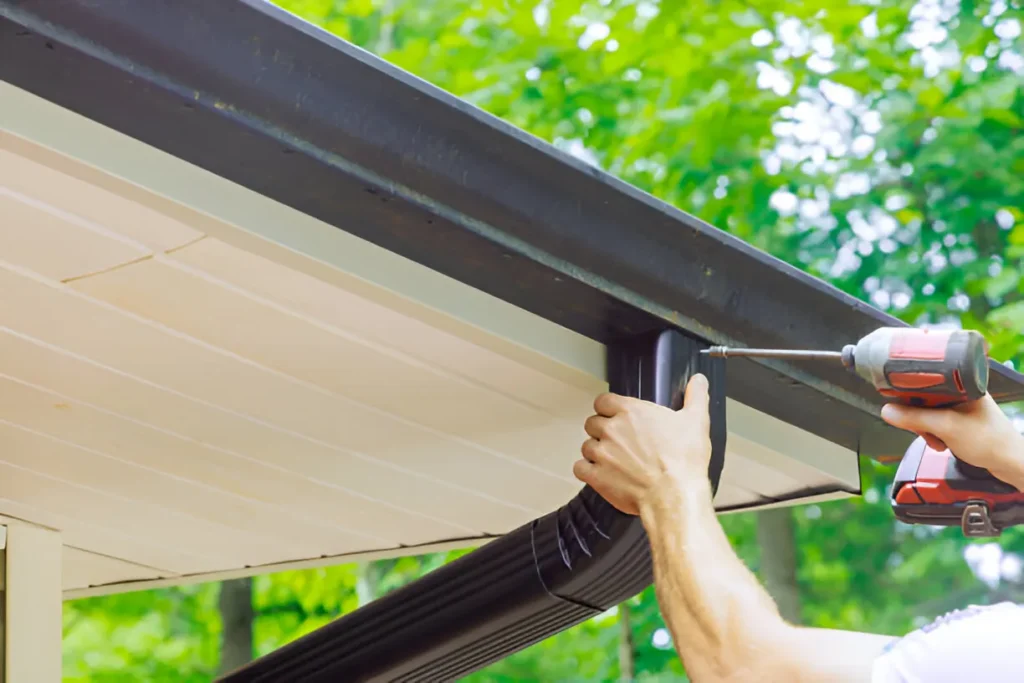
Without gutters and downspouts, rainwater can fall directly next to the house, which can cause cracks in the foundation, leaky basements, and damage to siding and landscaping.
In short, gutters and downspouts may seem small, but they play a big role in protecting your entire home from water damage.
8. Drip Edge
The drip edge is a thin metal strip or sheet, usually made of aluminum or galvanized steel, that runs along the edge of the roof, right under the shingles.
It’s not always visible, you could say, but it plays a very important role in protecting the roof from water damage by directing water away from the fascia and into the gutters.
Its main job is to:
- Direct rainwater away from the roof edge
- Guide water safely into the gutters
- Stop water from soaking into the roof deck and fascia board
Without a drip edge, rainwater can seep under the shingles and rot the wooden parts of your roof. It can also cause stains, leaks, and long-term damage to your home’s structure. That’s why every good roofing system includes a drip edge as a protective barrier at the roof’s edge.
9. Fascia
The fascia is the long vertical board that usually runs along the bottom edge of the roof. It is located just below the drip edge and behind the gutters.
It is usually made from wood, aluminum, or other materials, and it is often treated or protected to resist moisture, rotting, and water damage.
The fascia serves two main purposes:
- Supports the gutter system – The gutters are nailed or screwed into the fascia to stay in place.
- Provides a clean, finished look – It hides the roof edges and gives your home a smooth, tidy appearance.
Besides that, the fascia also acts as a protective layer between the edge of the roof and the outside world, shielding the roof deck and interior from water, insects, and weather damage. If water spills over clogged gutters, it can rot the fascia, so keeping gutters clean is important.
10. Soffit
The soffit is the part of the roof you see when you look up under the roof overhang (the part of the roof that sticks out past the wall). It’s usually made from vinyl, wood, or metal, and often has small holes or vents for airflow.
Here’s why soffits matter:
- Ventilation – They allow fresh air into the attic and help release hot, moist air. This reduces the risk of mold, ice dams, and roof damage.
- Pest control – Soffits help keep out insects, birds, and small animals that try to nest in your attic.
- Protection and appearance – Soffits close off the underside of the roof overhang, giving your home a cleaner look while protecting roof rafters from rain and humidity.
A well-ventilated soffit system is a must for any modern home because it keeps your attic healthy and extends the life of your entire roofing system.
What are the components of a residential roof diagram?
A residential roof diagram typically includes parts like shingles, underlayment, decking, rafters, fascia, soffit, ridge, and flashing.
What are the components of a residential roof and their functions?
They include structural and protective parts such as shingles (covering), decking (base), rafters (support), and flashing (waterproofing).
What are the 8 components of a roof?
Commonly, the 8 parts are decking, underlayment, shingles, flashing, fascia, soffit, rafters, and ridge.
What are the parts of a roof frame?
The roof frame includes rafters, ridge board, collar ties, ceiling joists, and trusses which form the skeleton of the roof.
What are the terminology parts of a roof?
Roof terminology includes terms like ridge, hip, valley, eave, gable, fascia, soffit, and flashing.
What is shown in a roof parts diagram?
A roof parts diagram visually identifies key structural and surface components of the roof system.
What are the parts of a roof and their functions?
Each part (like ridge, soffit, fascia) serves a function such as ventilation, water drainage, and structural support.

Hello! I’m Abdullah, a passionate professional in the field of construction and roofing. I am the proud owner of SJ Roofing & Venting, a leading construction company based in New York. With years of hands-on experience, I write about various construction methods, techniques, and industry insights to share my knowledge and help others in the field. I’m also the founder and main contributor of this website.

